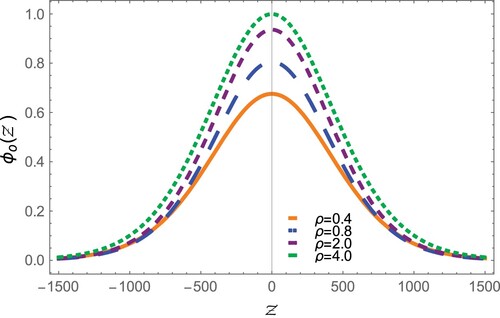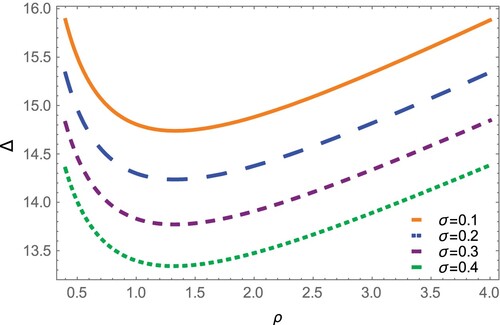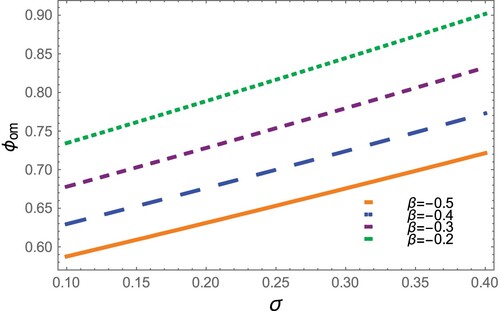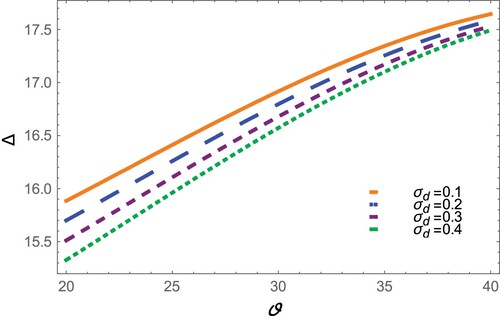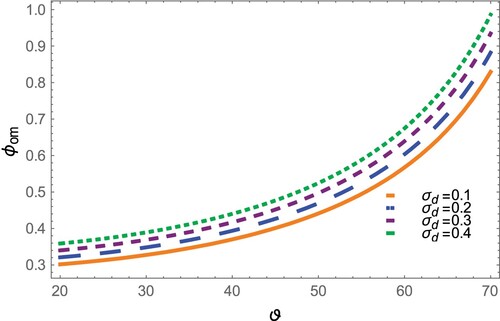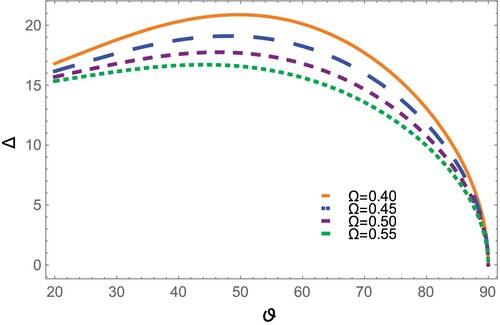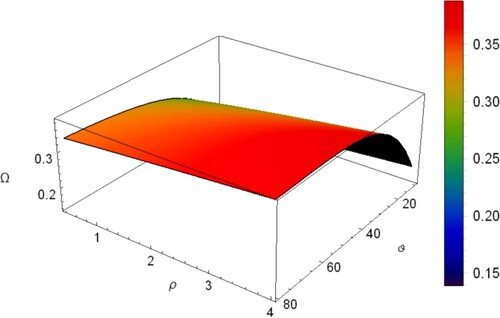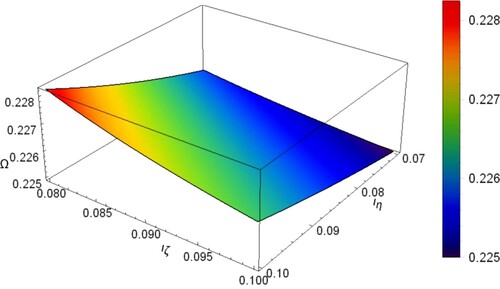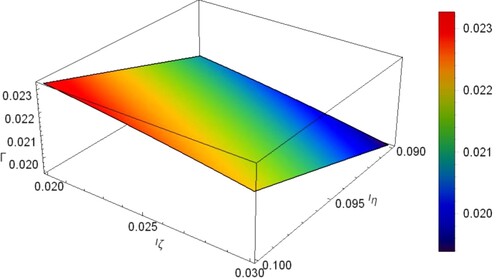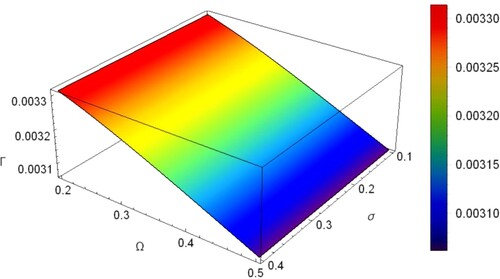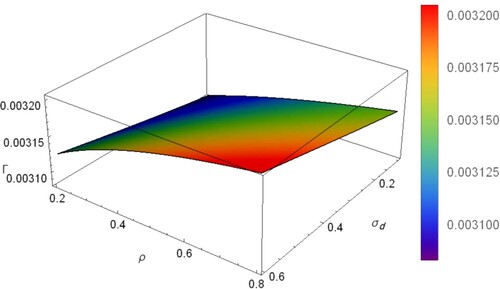 ?Mathematical formulae have been encoded as MathML and are displayed in this HTML version using MathJax in order to improve their display. Uncheck the box to turn MathJax off. This feature requires Javascript. Click on a formula to zoom.
?Mathematical formulae have been encoded as MathML and are displayed in this HTML version using MathJax in order to improve their display. Uncheck the box to turn MathJax off. This feature requires Javascript. Click on a formula to zoom.Abstract
Electrons in space plasma may follow vortex-like distribution, that is why we have derived the three-dimentional (3D) nonlinear modified Zakharov–Kuznetsov (mZK), describing the propagation of dust acoustic solitary to the plasma system composed of four components, magnetized charged dust plasma with electrons modelled by vortex-like distribution. By using the reductive perturbation method, it has been found that both solitary wave amplitude and width are affected by the plasma parameters: graim charge ratio ρ, population parameter β, and temperature ratio σ. The small-k perturbation technique has also been applied to study the instability criterion and growth rate of this instability. Cyclotron frequency Ω, temperature ratio , direction cosine (
and
), and grain charge ratio ρ are found to modify the instability growth rate Γ.
1. Introduction
The existence of dust charged particles has been noticed widely not only in space plasma (cometary tails, interstellar media, Earth ionosphere, planetary atmospheres, etc.) but also in laboratory [Citation1–5]. Recently, dust has also been observed in Hall thrusters [Citation6, Citation7]. The dynamics of nonlinear waves are found to have an increasingly important role in grasping the behaviour of multicomponents dusty plasma [Citation8–10]. The nonlinear and linear properties of one dimensional dust acoustic (DA) waves in coupled unmagnetized dusty plasmas have been investigated by many researchers [Citation11, Citation12]. Malik et al. [Citation13] have studied small amplitude DA solitary solution in two ion temperature magnetized plasma. ElWakil et al. [Citation14] have used the reductive perturbation technique to get the Zakharov Kuznetsov (ZK) equation representing the propagation of nonlinear small but finite amplitude DA waves in magnetized collisionless dusty plasma. El-Tantawy et al. [Citation15] have studied the nonlinear ion acoustic waves in a magneto plasma consisting of nonextensive distributed positrons, non-Maxellian electrons and cold ion fluid. Zaghbeer et al. [Citation16] have theoretically studied the effect of nonextensive electron and ion on DA rogue waves in dusty plasma of opposite polarity. Dusty plasma mainly supports two categories of acoustic waves: low frequency DA waves containing mobile dust particles and high frequency dust–ion acoustic (DIA) waves containing static dust particles and mobile ions [Citation17]. Both of these wave modes have been investigated experimentally [Citation18] and theoretically [Citation19–21]. The existence of DA waves was first theoretically predicted by Rao et al. [Citation22], with the inertia introduced by the dust particles and the restoring force introduced by the pressure of inertialess electrons and ions. Particles in thermodynamic equilibrium systems are described by Maxwellian distribution. However, laboratory, astrophysical and space plasma systems are found to be in a quasi steady state so particles such as electron and ions will deviate from Maxwellian distribution [Citation23]. The trapping of electrons is noticed in some laboratory plasma experiments as well as in space plasmas [Citation24, Citation25]. Hot electrons in most space plasmas follow the vortex-like distribution as a result of hot electrons trapping in the wave potential caused by phase space holes [Citation26]. On the other hand, laboratory experiments, diffraction limited laser–plasma interaction experiment where the low velocity wave corresponding to stimulated scattering from electron acoustic (EA) waves causes strong electron trapping, are noticed [Citation27]. The wave propagation in the plasma system containing trapped/vortex-like electron distribution has been discussed by many authors. Mamun and Shukla [Citation28] have derived the modified Korteweg–de Vries (mKdV) equation in collisionless plasma consisting of stationary ions, hot electrons modelled by vortex-like distribution and cold electron fluid. It has been shown that the EA solitary wave amplitude increases as the temperature of the trapped electron increases, but their width decreases. They also compared their results with the most noticeable features of the broad band electrostatic noise in the dayside auroral zone. Later on, Elwakil et al. [Citation29] have considered the solitary EA wave propagation in an unmagnetized collisionless plasma consisting of hot electrons modelled by vortex-like distribution, cold electron fluid and stationary ions, They have mathematically obtained higher-order solutions and have confirmed that these solutions in consistency with the original equation numerical solution. Recently, the study of wave solution of ZK equation and the coexistence of wave instability have been approached [Citation30–37]. Shalaby et al. [Citation38] have analysed the 3D instability of DIA solitary waves using the small-k expansion method. Their results showed that the propagation angle, nonisothermal electrons temperature, and external magnetic field strongly affect the criterion of the instability as well as the growth rate of this instability. Zaghbeer et al. [Citation39] have theoretically studied wave instability features in a collisionless magnetized dusty plasma system containing positively and negatively charged dusty particles, and they have found in that nonextensive parameter, the grain charge mass ratio and cyclotron frequency strongly modify the wave properties of the DA waves as well as the instability growth rate.
In this paper, DA solitary wave propagation have been investigated in a magnetized dusty plasma consisting of opposite polarity charged dust grains, trapped electrons modelled by vortex-like distribution and Maxwellian ion distribution. Using the reductive perturbation method [Citation40], we have derived mZK equation which is also known as mKdV equation in three dimension and its solution. We have also studied instability criterion and the growth rate. The outline of this paper is as follows. In Section 2, the basic equations representing the system are presented. In Section 3, mZK equation representing DA solitary wave propagation is derived. The instability analysis and the growth rate are computed in Section 4. Finally, conclusion is given in Section 5.
2. Governing system
In this system, we consider a collisionless magnetized dusty plasma consisting of four components, namely: negative cold dust grains, positive charged warm adiabatic dust grains, vortex-like electron distribution, and Maxwellian ion distribution [Citation41, Citation42]. The properties of DA solitary waves in a magnetized plasma with external magnetic field (where
is a unit vector in the z direction) can be depicted by the following normalized 3D fluid equations. For positive dust grains,
(1)
(1)
(2)
(2)
(3)
(3) For negative dust grains,
(4)
(4)
(5)
(5) Here, the quantities n, N (u, v) denote the perturbed densities (velocities) of positive and negative dusty grains and their corresponding equilibrium values are
. We have defined the quantities:
,
is the charges of the positive (negative) dust particles,
is the mass of the positive (negative) dust particles,
is the Boltzmann constant,
is the the positive dust (ion) temperature,
, and
,
.
represents the electrostatic potential,
is the thermal positive grains fluid pressure, and Ω is the dust cyclotron frequency.
Poisson equation reads
(6)
(6) where
is the electron (ion) density. Electrons are modelled by vortex-like distribution so we can write electron density
as [Citation43]
(7)
(7) where
and
can be defined as
where
is the error function. In case
, Equation (Equation7
(7)
(7) ) gives
(8)
(8) where
is the electron (ion) density. The electron density is expressed in Equation (Equation8
(8)
(8) ) by vortex-like distribution representing the trapping of hot electrons caused by the existence of phase space holes, where
is the ratio of the free hot electron temperature
to the hot trapped electron temperature
. It is obvious from Equation (Equation8
(8)
(8) ) that when ever
the electron density distribution is reduced to the well known Maxwellian distribution, In case of values of β
, a vortex-like excavated trapped electron distribution corresponding to an under population of trapped electrons, which is the case of our interest here.The ion density
is described by
(9)
(9) The velocities u and v are normalized by the the characteristic speed
, where
. The quantity ϕ is normalized by
. Space x and time t have been normalized by (negative dust plasma Debye length)
and (negative dust plasma frequency)
is normalized by
.
To discuss mZK (modified Zakharov–Kuznetsov) equation in 3D, we use the stretched coordinates,
(10)
(10) where ϵ measures the size of the perturbation amplitude and λ is the soliton phase speed. Expanding the parameters in Equations (Equation1
(1)
(1) )–( Equation9
(9)
(9) ) about equilibrium values as
(11)
(11)
(12)
(12) Charge neutrality condition reads
(13)
(13) The boundary conditions are given by
Substituting Equations (Equation10
(10)
(10) )–( Equation12
(12)
(12) ) in Equations (Equation1
(1)
(1) )–( Equation9
(9)
(9) ), collecting the coefficient of like powers in ϵ, we get the first-order equations as
(14)
(14) where
.
Next order in ϵ for positive dust gives
(15)
(15) Next order in ϵ for negative dust gives
(16)
(16) Poisson equation gives
(17)
(17) Eliminating quantities
, and
in Equations (Equation15
(15)
(15) )–( Equation17
(17)
(17) ), the mZK equation can be obtained in the form
(18)
(18) where
(19)
(19)
3. Solitary wave analysis for the mZK equation
To study the propagation of the solitary waves (SWs) in a magnetic field located in the plane, we first rotate the axes
by an angle ϑ (angle between propagating wave and Z axis), keeping Y axis fixed. We obtain the new variables,
(20)
(20) Equation (Equation18
(18)
(18) ) could be rewritten as
(21)
(21) where
(22)
(22) Substitute
in the form,
(23)
(23)
(24)
(24) the steady state form of mZK under transformation (Equation24
(24)
(24) ) becomes
(25)
(25) Applying boundary conditions:
at
, the soliton solution is obtained as
(26)
(26) where
is the soliton amplitude and
is width Δ. The effect of vortex-like electron distribution causes the soliton solution. Equation (Equation26
(26)
(26) ) to be proportional to
instead of
which is the solution for the same system with Maxwellian electron distribution. It is clear from Equation (Equation19
(19)
(19) ) that A and B are always positive for all the numerical values allowed for the system parameters. It means that this system supports only the propagation of solitary SWs associated with positive potential. This differ from the results found for the same system with nonextensive electron and ion distribution [Citation36] in which compressive (
) and rarefactive (
) soliton could exist depending on the value of grain charge ratio ρ Figure shows that the SWs amplitude
goes higher with increasing the values of ρ which indicates that the net charge of the charged dust grains affects the SWs amplitude but cannot make it negative. The SWs width is found to increase (decrease) with
(
) as shown in Figure . It is obvious from Equations (Equation26
(26)
(26) ), (Equation22
(22)
(22) ), and (Equation19
(19)
(19) ) that the temperature ratio β (
) does not change the width of the solitary waves. However, from Figure , the amplitude of the SWs is found to decrease with
. It is also clear from Figures and that the width (amplitude) of the SWs decreases (increases) with electrons to ion charge ratio σ. It seems from Figures and that as the charge ratio
increases the SWs width decreases but the amplitude increases. As the dust cyclotron frequency Ω increases, the dispersion effect increases which leads to a decrease in the SWs width, i.e. a stronger magnetic field causes narrower width. The effects of obliqueness angel ϑ on the SWs amplitude and width were illustrated in Figures and . It was shown that SWs amplitude increases with ϑ. However, the width is found to increase with ϑ at lower range
but decreases at higher range
.
4. Analysis of instability
To study the instability of obliquely propagating SWs, we use small-k perturbation expansion method [Citation32, Citation44] and assume that
(27)
(27) where
is the soliton solution in Equation (Equation26
(26)
(26) ), and ϕ is given by long wave length plane wave as
(28)
(28) where
are the direction cosine in which
. For small, k
and ω could be expanded as
(29)
(29)
(30)
(30) By substituting Equation (Equation27
(27)
(27) ) in Equation (Equation21
(21)
(21) ), we get the linearized form of Equation (Equation21
(21)
(21) ) as
(31)
(31) Our essential interest is to find
The zeroth order equation obtained from Equations (Equation28
(28)
(28) )–(Equation31
(31)
(31) ) after integration could be written as
(32)
(32) where h is the constant. Equation (Equation32
(32)
(32) ) is a coupled differential equation in terms of
and
. This equation has the same structure as that of Equation (Equation25
(25)
(25) ) under the following two solutions: [Citation45]
(33)
(33)
(34)
(34) The zeroth order solution could be given by
(35)
(35) where
and
are constants. Integrating Equation (Equation35
(35)
(35) ) under the condition
not tending to
as
tends to
,
simplified to
(36)
(36) The first-order equation with linear terms in k obtained from Equations (Equation26
(26)
(26) )–(Equation29
(29)
(29) ) and Equation (Equation34
(34)
(34) ) after integration expressed as
(37)
(37) where C is the integration constant and
and
are given by
(38)
(38) Using same steps in calculating
to get the general solution of the first-order equation
as
(39)
(39) Also, equation for
must be written as
(40)
(40) where
(41)
(41) Solution of Equation (Equation35
(35)
(35) ) exists when the right hand side in (Equation35
(35)
(35) ) is orthogonal to kernel of operator that adjoint to operator, [Citation45–47]
This kernel tend to zero as
. So, one can determining
from
(42)
(42) Now using
and
from (Equation36
(36)
(36) ) and (Equation39
(39)
(39) ), the dispersion relation can obtained as
(43)
(43) where
(44)
(44)
(45)
(45) It is obvious from dispersion relation (Equation43
(43)
(43) ) that there always instability if
. By using Equations (Equation19
(19)
(19) ), (Equation22
(22)
(22) ), (Equation38
(38)
(38) ), (Equation43
(43)
(43) ), (Equation44
(44)
(44) ), and (Equation45
(45)
(45) ), the criteria of instability must be
(46)
(46) where
(47)
(47) Figures and represent
surface plot in which the numerical values for the plasma parameters below the surface gives stable wave regime. Where numerical values above the surface plane represent unstable SWs. Figure gives the relation between the dust cyclotron frequency Ω, obliqueness angle ϑ and grain charge ratio ρ. It seems that as ϑ increases the value of Ω associated with the unstable SWs increases. It is also clear from this figure that as ρ increases the value of Ω associated with unstable SWs increases. Figure also represents
surface plot indicating the variation of Ω with the direction cosine
and
. This plot shows that as
increases the value of Ω associated with unstable SWs increases. On other hand as
increases, the value of Ω for which the solitary waves become unstable and decreases. The instability growth rate reads as
(48)
(48) From Equation (Equation48
(48)
(48) ), the growth rate Γ is linear in
and nonlinear in Ω,
,
, ϑ. The instability growth rate Γ variation with
,
, σ and Ω is shown in Figures and . Figure indicates the dependence of Γ on both
and
, the unstable perturbation growth rate Γ decreases (increases) with
(
). From Figure , the growth rate decreases slightly with Ω, but σ seems to have no effect on Γ. The grain charge ratio ρ and
are found to enhance the growth rate as shown in Figure .
5. Conclusion
Four components magnetized dusty plasma formed of mobile positively and negatively dusty particles, electron modelled by vortex-like distribution and Maxwellian ions have been represented. Using the reductive perturbation method, the mZK equation has been deduced. The 3D stability and instability for SWs governed by this mZK equation are examined using the small-k expansion technique. The results could be outlined as
As a result of trapped electron distribution, mZK equation has been obtained instead of the standard ZK equation in the case of Maxwellian electron distribution.
The soliton solution
for mZK equation (Equation25
(25)
(25) ) causes DA solitary waves to have smaller width, larger amplitude and higher propagation velocity compared with the solution
which is considered as a solution for well known ZK equation in the case of assuming Maxwellian electron distribution.
This system supports only the propagation of positive potential solitary waves.
The temperature ratio
is found to change the SWs amplitude only. As
decreases, the amplitude increases. On the other hand,
has no effect on the width of the SWs.
The increase in the grain charge ratio is found to make the amplitude of the SWs higher but cannot change its polarity. On other hand, the solitary wave width increases with
but decreases with
.
The cyclotron frequency Ω seems to have no effect on the SWs amplitude. However, it directly affects the width. It was noted that as Ω increases, the width decreases, i.e. cyclotron frequency Ω makes SWs more spiky.
Cyclotron frequency Ω, the temperature ratio
, direction cosine (
and
) and grain charge ratio ρ are found to modify the instability growth rate Γ of the SWs.Lastly, the current study can provide an explanation for the behaviour of the solitary structure which exists in the four component dusty plasma system with dust opposite polarity, ion Maxwellian distribution and vortex-like electron distribution, which allows us to detect the DA solitary wave and to identify their stability and instability features as it was theoretically predicted in this investigation.
Disclosure statement
No potential conflict of interest was reported by the author(s).
References
- Shukla PK. Dust ion-acoustic shocks and holes. Phys Plasmas. 2000;7:1044.
- Morfill GE, Ivlev AV. Complex plasmas: an interdisciplinary research field. Rev Mod Phys. 2009;81:1353.
- Angelis UD, Bingham R, Tsytovich VN. Dispersion properties of dusty plasmas. J Plasma Phys. 1989;42:445.
- Angelis UD, Forlani A, Bingham R, et al. Damping and absorption of high-frequency waves in dusty plasmas. Phys Plasmas. 1994;1:236.
- Bingham R, Angelis UD, Tsytovich VN, et al. Electromagnetic wave scattering in dustry plasmas. Phys Fluids B. 1991;3:811–817.
- Malik HK, Tyagi J, Sharma D. Growth of Rayleigh instability in a Hall thruster channel having dust in exit region. AIP Adv. 2019;9:Article ID 055220.
- Tyagi J, Sharma D, Malik HK. Discussion on Rayleigh equation obtained for a Hall thruster plasma with dust. J Theor Appl Phys. 2018;12:227.
- Tomar R, Bhatnagar A, Malik HK, et al. Evolution of solitons and their reflection and transmission in a plasma having negatively charge dust grains. J Theor Appl Phys. 2014;8:138.
- Malik R, Malik HK. Compressive solitons in a moving e-p plasma under the effect of dust grains and an external magnetic fields. J Theor Appl Phys. 2013;7:65.
- Kumar R, Malik HK. Modified Korteweg–de Vries soliton reflection in a magnetized plasma with dust grains and trapped electrons. Phys Plasmas. 2013;20:Article ID 032112.
- Kaw PK, Sen A. Low frequency modes in strongly coupled dusty plasmas. Phys Plasmas. 1998;5:3552–3559.
- Shukla PK, Stenflo L. Transverse shear waves generating vortex-like dust fluid motions in strongly coupled dusty plasmas. Phys Lett A. 2003;315:244–247.
- Malik HK, Srivastava R, Kumar S, et al. Small amplitude dust acoustic solitary wave in magnetized two ion temperature plasma. J Taibah Univ Sci. 2020;14:417.
- El-Wakil SA, Attia MT, El-Shewy EK, et al. Dust-acoustic solitary waves in magnetized dusty plasma with dust opposite polarity. Appl Appl Math. 2011;6:211–220.
- El-Tantawy SA, El-Bedwehy NA, Abd El-Razek HN, et al. Large amplitude solitary waves in a warm magnetoplasma with kappa.distributed electrons. Phys Plasmas. 2013;20:1–5.
- Zaghbeer SK, Salah HH, Sheta NH, et al. Effect of nonextensive electron and ion on dust acoustic rogue waves in dusty plasma of opposite polarity. Astrophys Space Sci. 2014;353:493–500.
- Kundu SK, Ghosh DK, Chatterjee P, et al. Shock waves in a dusty plasma with positive and negative dust, where electrons are superthermally distributed. J Phys. 2011;38:409–419.
- Johnson JC, Angelo ND, Merlino RL. A double layer induced ionisation instability. J Phys D. 1990;23:682–685.
- Hase Y, Watanabe S, Tanaca H. Cylindrical ion acoustic soliton in plasma with negative ion. J Phys Soc Japan. 1985;54:4115–4125.
- Duan WS, Shi YR, Hong XR. Theoretical study of resonance of the Kadomtsev–Petviashvili equation. Phys Lett A. 2004;323:89–94.
- Mamun AA, Shukla PK. Cylindrical and spherical dust ion–acoustic solitary waves. Phys Plasmas. 2002;9:1468–1470.
- Rao NN, Shukla PK, Yu My. Dust-acoustic waves in dusty plasmas. Planet Space Sci. 1990;38:543–546.
- Schamel H. Stability of electron vortex structures in phase space. Phys Rev Lett. 1982;48:481–483.
- Saeki SK, Michelsen P, Pécseli HL, et al. Formation and coalescence of electron solitary holes. Phys Rev Lett. 1979;42:501–504.
- Guio P, Brve S, Daldorff LKS, et al. Phase space vortices in collisionless plasmas. Nonlinear Process Geophys. 2003;10:75–86.
- Schamel H. Electron holes, ion holes and double layers: electrostatic phase space structures in theory and experiment. Phys Rep. 1986;140:161–191.
- Montgomery DS, Focia RJ, Rose HA, et al. Observation of stimulated electronacoustic wave scattering. Phys Rev Lett. 2001;87:1–4.
- Mamun AA, Shukla PK. Electron-acoustic solitary waves via vortex electron distribution. J Geophys Res. 2002;107:1–5.
- Elwakil SA, El-Shewy EK, Zahran MA. Higher-order solution of an electron acoustic solitary waves via vortex electron distribution. Chaos Solit Fractals. 2004;22:13–24.
- Parkes EJ, Munro S. The stability of obliquely-propagating solitary-wave solutions to Zakharov–Kuznetsov-type equations. J Plasma Phys. 2005;71:695–708.
- Haider MM, Ferdous T, Duha SS. The effects of vortex like distributed electron in magnetized multi-ion dusty plasmas. Cent Eur J Phys. 2014;12:701–706.
- Haider MM, Ferdous T, Duha SS. Instability due to trapped electrons in magnetized multi-ion dusty plasmas. J Theor Appl Phys. 2015;9:159–166.
- Moslem WM, Ali S, Shukla PK, et al. Solitary, explosive, and periodic solutions of the quantum Zakharov–Kuznetsov equation and its transverse instability. Phys Plasmas. 2007;14:Article ID 082308.
- Bashir MF, Behery EE, El-Taibany WF. Effect of anisotropic dust pressure and superthermal electrons on propagation and stability of dust acoustic solitary waves. Phys Plasmas. 2015;22:Article ID 062112.
- Ahmad R, Gul N, Adnan M, et al. Nonlinear electrostatic solitary pulses in magnetized quantum plasma with relative density effects of spin-up and spin-down electrons. Phys Plasmas. 2016;23:Article ID 112112.
- Williams G, Kourakis I. On the existence and stability of electrostatic structures in non-Maxwellian electron-positron-ion plasmas. Phys Plasmas. 2013;20:Article ID 122311.
- El-Shewy EK, Zaghbeer SK, El-Rahman AA. Three-dimensional instability of opposite polarity nonthermal dusty plasma. Z Naturforsch A. 2018;74:131–138.
- Shalaby M, EL-Labany SK, EL-Shamy EF, et al. Three-dimensional instability of dust ion-acoustic solitary waves in a magnetized dusty plasma with two different types of nonisothermal electrons. Phys Plasmas. 2010;17:Article ID 113709.
- Zaghbeer SK, El-Shewy EK, El-Hanbaly AM, et al. On the growth rate instability of nonextensively opposite polarity dusty plasmas. Adv Space Res. 2018;62:1728–1736.
- Washimi H, Taniuti T. Propagation of ion-acoustic solitary waves of small amplitude. Phys Rev Lett. 1966;17:996.
- Barkan A, DAnglo N, Marlino RL. Expriments on ion-acoustic waves in dusty plasma. Planet Space Sci. 1996;44:239–242.
- Melandso F. Lattice waves in dust plasma crystals. Phys Plasmas. 1996;3:3890–3901.
- Schamel H. Stationary solitary, snoidal and sinusoidal ion acoustic waves. Plasma Phys. 1972;14:905–924.
- Anowar MGM, Mamun AA. Effects of two-temperature electrons and trapped ions on multidimensional instability of dust-acoustic solitary waves. IEEE Trans Plasma Sci. 2009;37:1638–1645.
- El-Labany SK, Moslem WM, Elneely NK. Stability of obliquely propagating 3D solitons in magnetized plasma with nonthermal distribution. Adv Space Res. 2020;66:266–277.
- Mamun AA. Instability of obliquely propagating electrostatic solitary waves in a magnetized nonthermal dusty plasma. Phys Scr. 1998;58:505–509.
- Zaghbeer SK, El-Shewy EK. On the wave instability of multi component electron acoustic plasma. Phys Scr. 2021;96:Article ID 125619.

